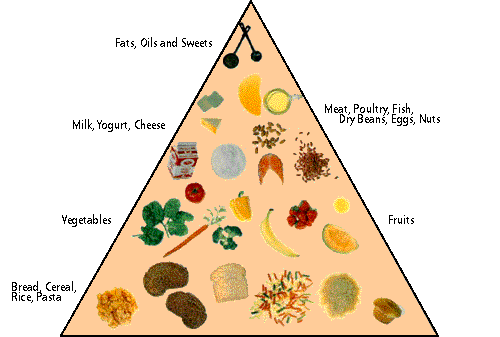
It isn't always easy or convenient to maintain a healthy diet while juggling the rigors of
college life. Getting enough fruits and veggies isn't usually a top priority when compared to classes, labs, sports, and various social activities.
In particular, most freshman are warned over and over about the terrible
"Freshman Fifteen". Incidentally, the concept of the "Freshman Fifteen" is purely myth.
By being knowledgeable and making a few wise choices, even the most stressed college student will
be able to choose a healthy diet.
The first thing that I want to emphasize is that DIETS DON'T WORK!!! In fact, studies have shown that dieting causes weight gain. After 8 hours of caloric restriction, basal metabolism rate will decrease by 15%, which makes it harder for the body to burn off the calories that are consumed.
The Food Guide Pyramid is a good guideline as to what to consume each day.

Your mother was right when she told you that breakfast is the most important meal of the day. Literally, breakfast "breaks" the "fast" that occurred during sleep. If you regularly have a hard time concentrating in morning classes, it may be because your brain is underfed. Glucose is the main source of fuel for the brain and can be found in complex carbohydrates, such as bagels and cereals. If you think that there isn't time to eat in the morning, make your breakfast portable and eat it in the car or on the walk to class.
It is usually cheaper and more nutritous to pack a lunch, rather than ordering out or going the take-out route. Many campus dinig halls offer sandwiches, salads and soups as staples in their menus now. Beware some fat traps that hide in otherwise nutritous foods. If you decide to eat a salad, choose a lowfat dressing or vinegar. Keep cheese to a minimum, although it is a good source of calcium. Beans, such as red-kidney beans and garbanzo beans, are a good source of protein. When given a choice, try to opt for dark green lettuce, such as romaine, rather than iceberg. Romaine has more nutrients whereas iceberg lettuce contains mostly water and very few nutrients.
Whole wheat breads provide more nutrients and fiber than white bread. Also, condiments on sandwiches can be a huge pitfall; mustard and ketchup are fat free and have less calories than mayonnaise. In addition, cream-based soups, such as clam chowder and cream-of-broccoli, have a lot higher fat and calorie content than broth-based soups like chicken noodle.
By making a few changes, you can really affect the impact of food on your body.
| You usually eat this: | Try this instead: |
| White bread | Whole-wheat bread |
| Sugared breakfast cereal | Low-sugared cereal (Total, Cheerios, Life) |
| Cheeseburger and french fries | Hamburger (without the mayo) and baked beans (less fat and cholesterol) |
| Potato salad | Three-bean salad |
| Doughnut, chips, salty snacks | Bran muffin or bagel, with little or no cream cheese |
| Soft drinks | Diet soft drinks |
| Boiled vegetables | Steamed vegetables (more nutrients) |
| Canned vegetables | Frozen vegetables (more nutrients) |
| Fried meats | Broiled meats |
| Fatty meats, like ribs | Lean meats, like ground round, chicken and fish |
| Whole milk and ice cream | Low-fat or nonfat milk and sherbert or frozen yogurt |
| Mayonnaise and sour cream salad dressings | Oil and vinegar dressings or low-calories versions |
| Cookies for a snack | Air-popped popcorn |
| Heavily salted foods | Foods flavored primarily with herbs, spices and lemon juice |
| Meal | Servingd/food group | |
| Breakfast | ||
| 1 peeled orange | 1 fruit | |
| 1-1/2 cups Cheerios with 1/2 cup lowfat milk | 2 bread, 1/2 milk | |
| 1 slice raisin toast with 1 tsp margarine | 1 fat/sweet | |
| Lunch | ||
| 2 slices whole wheat bread | 2 bread | |
| 2 oz. ham | 1 meat | |
| 2 tsp mustard | ||
| 1 apple | 1 fruit | |
| 2 small oatmeal raisin cookies | 2 fat/sweet | |
| 3pm Study Break | ||
| 1 whole bagel | 2 bread | |
| 1 Tbsp. peanut butter | 1/4 meat | |
| 1/2 cup lowfat milk | 1/2 milk | |
| Dinner | ||
| 1 cup romaine lettuce | 1 vegetable | |
| 1/2 cup sliced tomatoes | 1 vegetable | |
| 1 Tbsp. Thousand Island Dressing | 1 fat/sweet | |
| 1/2 grated carrot | 1/2 vegetable> | |
| 3 oz. broiled salmon | 1 meat | |
| 1/2 cup rice | 1 bread | |
| 3/4 cup green beans with 1 tsp. margarine | 1 vegetable, 1 fat/sweet | |
| Late-night snack | ||
| 1 cup lowfat fruit yogurt | 1 milk |